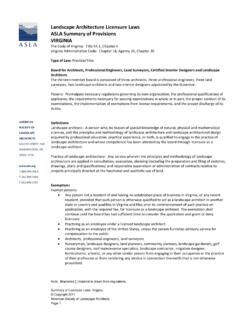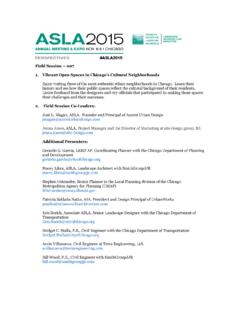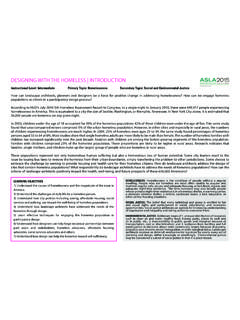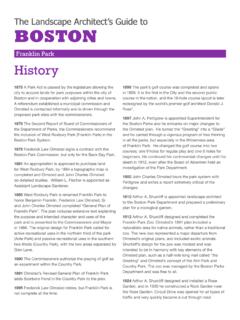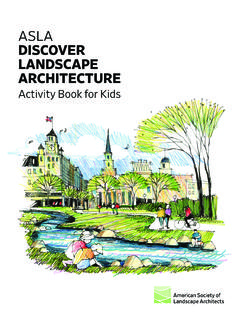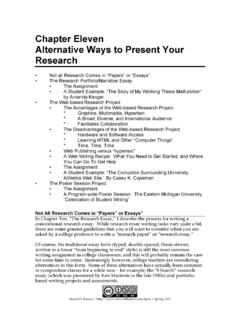Transcription of ASLA - Civic Leadership and City Design
1 Civic Leadership : Integrating Design into Local Government and Public Infrastructure Cash- strapped cities across America are looking for innovative ways of getting the most public benefit out of limited infrastructure dollars. Panelists include designers and a former mayor who will share experiences and case studies of incorporating Design excellence into public projects and the many community co- benefits those projects will create. Learning Objectives 1) Know how to work with local elected officials to promote Design and livability in infrastructure and engineering projects.
2 2) Understand what motivates local leaders, and what mayors can do to improve the quality of the built environment and advance green Design practices. 3) Learn new approaches to Civic Design and implementation that are replicable to your practice and community. 4) Learn how local elected officials are addressing Design through a variety of city offices and initiatives. Panel Bios: Moderator: Trinity Simons Director, Mayors Institute on City Design As Director of the Mayors Institute on City Design , Trinity Simons works with mayors across the country on their most pressing city Design challenges.
3 She currently serves as on the Board of Directors of Association for Community Design and has previously served on the Board of Directors of the NAAB, ACSA, AIAS, and the DC chapter of the AIA. She has a Bachelor of Architecture from the University of Arkansas and a Master of City Planning from the Massachusetts Institute of Technology. Panelist: Julia Czerniak, ASLA Professor of Architecture, Syracuse University Partner, CLEAR Professional Advisor, Movement on Main JULIA CZERNIAK, ASLA, is a Professor of Architecture at Syracuse University, formerly the inaugural Director of UPSTATE.
4 She is a registered landscape architect and founder of CLEAR, an interdisciplinary Design practice that focuses on urban landscapes in Rust- Belt cities. Her work as designer is complemented by a body of writing including three books. Large Parks (2007) and Case: Downsview Park Toronto (2001) focus on contemporary Design approaches to public parks and the relationship between landscape and cities. Her edited volume, Formerly Urban: Projecting Rust Belt Futures (2013) which examines potential futures for shrinking cities, was released this year Panelist: Stephen Luoni, ASLA Director, University of Arkansas Community Design Center (UACDC), Steven L.
5 Anderson Chair in Architecture and Urban Studies Stephen Luoni is director of the University of Arkansas Community Design Center (UACDC) where he is the Steven L. Anderson Chair in Architecture and Urban Studies. His Design and research have won more than fifty Design awards, including Progressive Architecture Awards, American Institute of Architects Honors Awards, a Charter Award from the Congress for the New Urbanism, and American Society of Landscape Architecture Awards, all for planning and urban Design . His work at UACDC specializes in interdisciplinary public works projects combining landscape, urban and architectural Design .
6 Luoni has a BS in Architecture from Ohio State University and a Master of Architecture from Yale University. Panel Outline: General Format: Moderator Trinity Simons will kick off the session with a 10- minute introduction. Each panelist will give 15- minute presentations on the topics described below. Following, the moderator will key up a few questions, and then take questions from the audience. 1) Moderator s Introduction: The Mayor as Chief Urban Designer a) Mayors have the potential to be powerful advocates for high- quality urban Design and public spaces b) Examples of Mayors as Chief Urban Designers over time c) Brief introduction to the Mayors Institute on City Design i) Partnership program of the National Endowment for the Arts, the American Architectural Foundation and the United States Conference of Mayors ii) Founded in 1986 by Mayor Joseph P.
7 Riley, Jr, the Mayor of Charleston, SC iii) Over the last 28 years, have worked with over 1,000 mayors and 700 Design and development professionals iv) How ASLA members can get involved d) Trends that we re seeing in city government and urban development i) Tech and innovation ii) Mayors get it don t always know that policies they have in place are hindering good Design and development iii) Cities are still doing long- term planning, but are looking for quick wins iv) Cities are looking to make the most out of every dollar the day of single objective projects is over (this is where we ll focus our panel).
8 2) Panelists a) Julia Czerniak - - Design Strategies for activating urban life in resource challenged cities. i) Syracuse Connective Corridor: a two- mile strip of transit- based urban landscape connecting Syracuse University with downtown, linking the city s cultural venues. (1) Innovating public/private frameworks enabled by anchor institutions (2) Engaging communities of experts composed of scholars, professionals, and citizens from public, private, and nonprofit sectors (3) Using funding streams to leverage urban Design opportunities. ii) Near Westside Neighborhood Plan: Design strategies for a fractured inner city neighborhood.
9 (1) Strategizing how to hybridize the infrastructural with the Civic to guide reinvestment. (2) Approaching how can designers give equal status to work that should be done improvements with Civic and social purpose and work that must be done such as transportation infrastructure, storm- water control, roadway reapportioning etc. (3) Revaluing property based on maintenance capabilities. iii) Onondaga Creek Corridor: A mile green corridor that is a new recreational and ecological spine thorough the city (1) Examining land acquisition after the city (2) Strategizing how Design can galvanize public support to change policy (3) Probing the potential of incremental Design b) Stephen Luoni Working with the Mayor i) The Creative Corridor: A Main Street Revitalization for Little Rock (1) The Creative Corridor retrofits a four- block segment of a neglected historic Main Street in downtown Little Rock.
10 The proposal is based on economic development driven by the introduction of an arts economy rather than resuscitation of the street s traditional retail base that decamped to the suburbs fifty years ago. (2) The project approach is premised on the role of the street in capturing value through townscaping strategies that feature low impact development landscapes, architectural frontages, public art, signage, and shared street geometries. Working with the mayor as the client was especially helpful since most of the recommendations in this Complete Street proposal were non- conforming with current codes.

